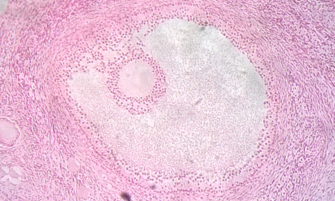
Follicular atresia refers to the process in which a follicle fails to develop, thus preventing it from ovulating and releasing an egg.[1] It is a normal, naturally occurring progression that occurs as mammalian ovaries age. Approximately 1% of mammalian follicles in ovaries undergo ovulation and the remaining 99% of follicles go through follicular atresia as they cycle through the growth phases. In summary, follicular atresia is a process that leads to the follicular loss and loss of oocytes, and any disturbance or loss of functionality of this process can lead to many other conditions.[2]
- ^ McGee EA, Horne J (2018). "Follicle Atresia". In Skinner MK (ed.). Encyclopedia of Reproduction (Second ed.). Oxford: Academic Press. pp. 87–91. doi:10.1016/b978-0-12-801238-3.64395-7. ISBN 978-0-12-815145-7.
- ^ Liu Z, Li F, Xue J, Wang M, Lai S, Bao H, He S (August 2020). "Esculentoside A rescues granulosa cell apoptosis and folliculogenesis in mice with premature ovarian failure". Aging. 12 (17): 16951–16962. doi:10.18632/aging.103609. PMC 7521512. PMID 32759462.